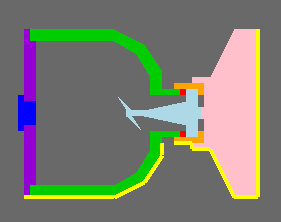
The long-term vision for this work is a CAD tool which can provide immediate feedback to a team of product designers about the ease of assembling the proposed product.
Given a geometric description of an assembly, Atlas will generate an assembly sequence and a fixture for that assembly. The fixture is represented as a continuum of possible fixturing locations, rather than as a finite set of discrete elements.
An example of Atlas' output appears below. The yellow line shows the final (non-minimized) fixture; the corresponding assembly sequence inserts the rightmost part downward, then all other parts from left to right. This assembly and every intermediate subassembly are guaranteed to be stable under gravity and all insertion forces.

Assembly Sequence: Starting with the empty fixture, Insert part 6 in direction (0, -1). Insert part 3 in direction (1, 0). Insert part 2 in direction (1, 0). Insert part 1 in direction (1, 0). Insert part 0 in direction (1, 0). Insert part 4 in direction (1, 0). Insert part 5 in direction (1, 0).
Although the current implementation of Atlas is restricted to planar assemblies, all of its techniques extend to the three-dimensional case as well.
B. Romney, "Issues in the Co-Design of Assembly Sequences and Fixtures".Manuscript.
